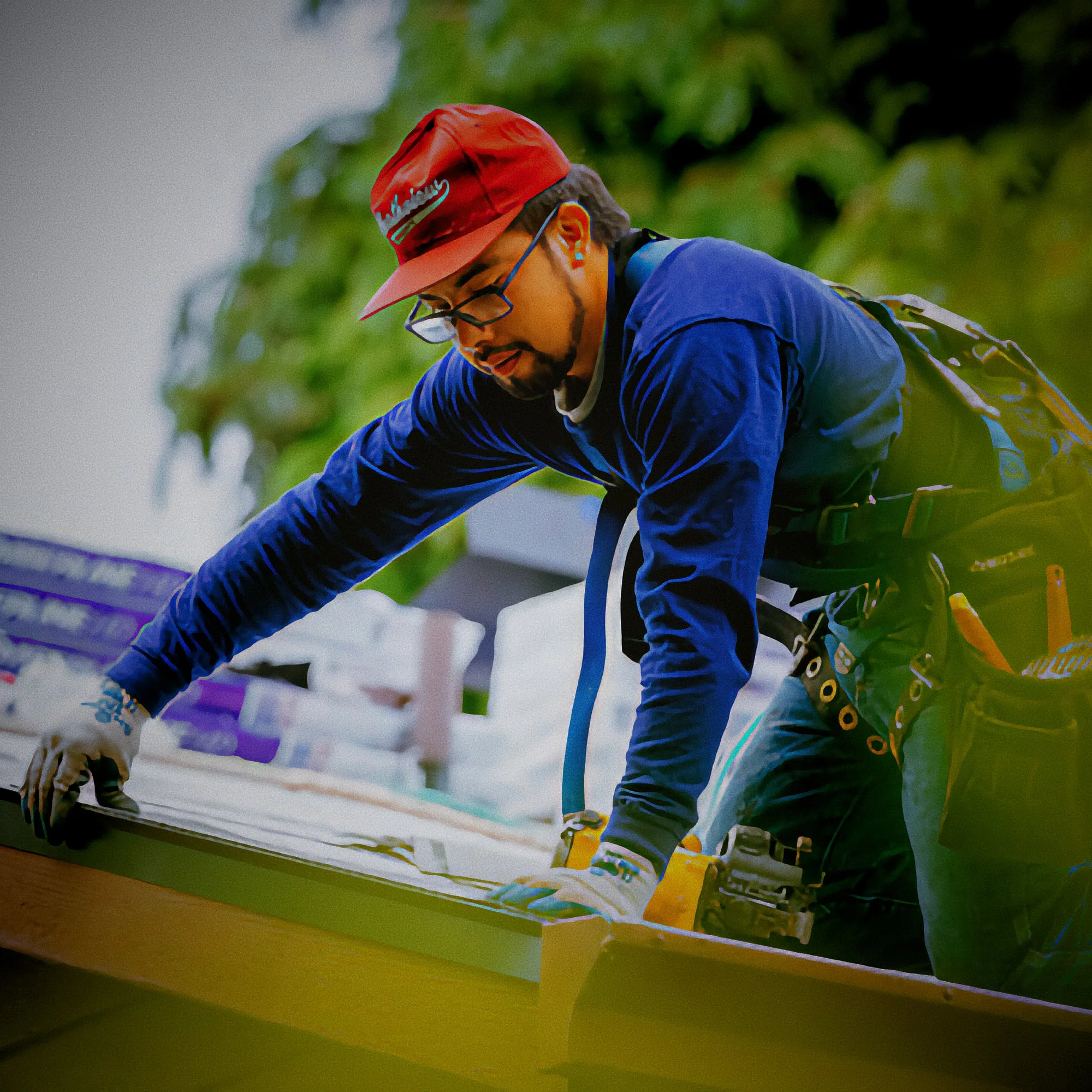The layers below your shingles form the backbone of your roofing system, defending your home against rain, wind, snow, and extreme temperatures. Each component serves a specific purpose, and proper installation plus regular maintenance determines how well your roof performs over its lifetime.
The visible shingles represent only the top layer of a complex system. Below them, multiple materials work together to create a waterproof barrier, provide structural support, and regulate temperature and moisture. From the structural decking that bears the weight of your entire roof to the ventilation systems that prevent costly ice dams and moisture damage, every element contributes to your home’s safety and energy efficiency.
Here, we will examine each component beneath your shingles, explaining how they protect your investment and why quality installation matters. You’ll learn what materials to expect during a roof inspection and how climate factors influence the specific requirements for your area.
What Goes Under Roof Shingles: A Complete Guide
A properly constructed roof system consists of several critical components working together to create a durable, weatherproof barrier.
Roof Decking
The roof decking serves as the structural backbone of your entire roofing system. This layer is typically constructed from plywood, oriented strand board (OSB), or in older homes, solid wood planking. Plywood remains the most common choice, usually ranging from ½” to ¾” thick, while OSB offers a more cost-effective alternative. The decking is securely fastened to the roof rafters or trusses, providing the necessary structural support to bear the weight of all roofing materials, snow loads, and wind forces.
Underlayment
Applied directly over the roof decking, underlayment acts as a secondary water barrier beneath the shingles. Traditional felt underlayment, made from asphalt-saturated felt in 15-pound or 30-pound weights, has been used for decades but is increasingly being replaced by synthetic alternatives. Synthetic underlayment, made from polypropylene or polyethylene, offers superior durability, tear resistance, and UV protection. While more expensive, synthetic materials can withstand longer exposure times during construction and provide better long-term performance. Learn more about all the kinds of underlayment.
Ice and Water Shield
This self-adhering membrane provides critical protection in vulnerable roof areas. Ice and water shield is typically installed along eaves, in valleys, and around roof penetrations like chimneys, skylights, and vent pipes. In cold climates, this membrane should extend at least three to six feet up from the roof edge to prevent water infiltration from ice dams and wind-driven rain. The self-sealing properties of this material create a watertight seal around nail penetrations.
Flashing Systems
Metal flashing serves as the roof’s water management system, directing water away from critical transition points and penetrations. Step flashing protects wall and roof intersections, while valley flashing channels water where two roof slopes meet. Specialized flashing systems protect areas around plumbing vents, exhaust fans, and chimneys. Proper flashing installation is crucial because these areas are the most common sources of roof leaks.
The Invisible Component: Roof Ventilation
Proper attic ventilation represents one of the most critical yet often overlooked aspects of roofing systems. Effective ventilation serves multiple purposes including moisture control, temperature regulation, ice dam prevention, energy efficiency improvement, and extending the lifespan of roofing materials.
A well-designed ventilation system creates continuous airflow from the eaves to the ridge. Soffit vents installed under roof eaves allow cool outside air to enter the attic space, while ridge vents running along the roof peak provide outlets for hot air to escape. This natural convection process maintains balanced attic temperatures and prevents moisture buildup that can lead to mold growth and wood rot.
Alternative ventilation options include gable vents located at roof ends, turbine vents that use wind power to actively remove hot air, static roof vents for basic exhaust, and powered exhaust fans for enhanced air movement. However, the most effective approach typically combines soffit vents for intake with ridge vents for exhaust, creating balanced airflow throughout the attic space.
Energy and Performance Benefits
The interaction between all these components significantly impacts your home’s energy efficiency and comfort. During summer months, proper ventilation reduces attic temperatures, which decreases the load on air conditioning systems and lowers cooling costs. In winter, balanced ventilation prevents heat buildup that can cause ice formation and potential roof damage.
The insulation layer, while not directly under the shingles, works in conjunction with these roof components. Typically placed on the attic floor rather than against the roof decking, insulation creates a thermal barrier that improves energy efficiency. However, insulation must be installed carefully to avoid blocking soffit vents or disrupting airflow paths.
Climate Considerations
Different climate zones require specific adaptations to this basic roof system. Cold climates demand enhanced ice and water shield coverage and adequate insulation to prevent ice dam formation. Hot climates benefit from reflective underlayment and enhanced ventilation to manage extreme temperatures. Coastal areas may require upgraded flashing materials and enhanced moisture protection due to salt air exposure.
Understanding these roof components and their interactions helps homeowners make informed decisions about maintenance, repairs, and replacements. Each element plays a vital role in creating a roofing system that protects your home while optimizing energy performance and ensuring long-term durability.
Frequently Asked Questions: What Is Under Shingles on a Roof
Our most frequently asked questions about what goes underneath the shingles of a roof
What materials are typically found under roof shingles?
Under roof shingles, you’ll typically find roof decking made from plywood or OSB that provides structural support, followed by underlayment (felt or synthetic material) that acts as a water barrier. In vulnerable areas like eaves and valleys, ice and water shield provides additional protection, while metal flashing directs water away from penetrations like vents and chimneys. The system also includes ventilation components and insulation to regulate temperature and moisture levels.
How does the underlayment protect a roof?
Underlayment protects a roof by serving as a secondary water barrier beneath the shingles, preventing moisture from reaching the roof decking if water penetrates through damaged or missing shingles. Made from felt or synthetic materials, it also provides temporary weather protection during construction and helps create a smooth, even surface for shingle installation while allowing the roof system to shed water effectively even when the primary shingle layer is compromised.
What is the purpose of roof decking under shingles?
Roof decking serves as the structural foundation of the roofing system, providing a solid base for shingles and all other roof components. Made from plywood or OSB and fastened to the rafters, it distributes the weight of roofing materials, snow loads, and wind forces across the roof structure while creating a stable platform for proper shingle installation and attachment.
Are there insulation materials used beneath shingles?
Insulation materials are not typically installed directly beneath shingles, as this would interfere with proper ventilation and could trap moisture. Instead, insulation is usually placed on the attic floor below the roof structure, creating a thermal barrier between the living space and attic while allowing necessary airflow between the roof decking and shingles to prevent moisture buildup and maintain proper ventilation.
How can I tell if the underlayment is damaged?
You can identify damaged underlayment by looking for visible signs from inside the attic such as water stains, discoloration, or sagging areas on the roof decking, as well as daylight showing through small holes or tears. From outside, missing or damaged shingles may expose the underlayment directly, revealing cracks, tears, or deteriorated areas, while water leaks during rain or evidence of moisture damage in your home’s interior often indicate compromised underlayment that’s no longer providing adequate protection.
Choose DaBella for Your Next Roof Replacement
Planning a roof replacement requires expertise in every layer of your roofing system. DaBella brings GAF Master Elite certification and over a decade of experience to every project across the United States. Our crews know how each component beneath your shingles affects your home’s protection and energy efficiency.
We handle complete roofing systems from structural decking to final shingle installation. Our team uses premium materials and proven installation techniques to create roofs built for your local climate conditions. Every project includes proper underlayment, flashing, and ventilation systems designed to prevent leaks and extend your roof’s lifespan.
Ready to protect your home with a professionally installed roof? Contact us today at 844-DaBella today to schedule your consultation. Our roofing specialists will assess your current system, explain your options, and provide a detailed estimate for your replacement project.

